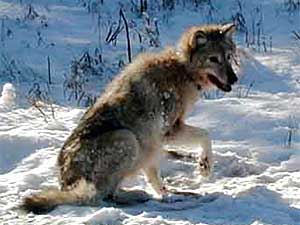|
Audio
Photos
More from MPR
Resources
Your Voice
|
Debate continues over whether wolves should remain protected
September 1, 2004
Thirty years ago, gray wolves were nearly extinct in the lower 48 states. The gray wolf has been on the endangered species list since 1974. Now, U.S. Fish and Wildlife officials say the animal has made a remarkable recovery. At a hearing in Bemidji Tuesday night, the agency took public testimony on a proposal to remove endangered species protections and turn gray wolf management over to the states. But not everyone favors removing gray wolves from federal protection.
Bemidji, Minn. — Even before the public hearing began, gray wolf defenders gathered outside Bemidji State University. A group of mostly Native Americans rallied in opposition to delisting the wolves. The rally was sponsored by the Bemidji-based Indigenous Environmental Network.
Tom Goldtooth, director of the organization, says many Indian tribes, especially in the Great Lakes region, have a deep spiritual relationship with the wolf.
 | |||
"Part of their essence within their clan -- of who they are, their relationship to the earth and to each other and to the cosmos -- is connected to the wolf, their brother," said Goldtooth.
Federal officials estimate there are close to 2,500 gray wolves in Minnesota. If the wolves are taken off the endangered species list, management of the population would be turned over to the Department of Natural Resources. That management plan was made into state law in 2000, but some environmentalists still oppose its provisions.
The DNR plan would maintain a minimum statewide population of 1,600 wolves. It would allow anyone to kill a wolf if it's in the act of stalking or attacking livestock or pets. Farmers in the lower two-thirds of the state would be allowed to kill wolves even if there's no sign of threatening behavior.
Karlyn Berg lives near Grand Rapids. She's been a wolf advocate since 1969. Berg opposes killing wolves to manage their population. She worries the state plan will turn back the clock on the gray wolf.
"It'd be different if there was absolutely no other option," said Berg. "But I think it's ludicrous that we've had 40 years of studying wolves in the federal capacity, and yet when it comes to designing a plan, we're going right back to exactly what caused them to be endangered in the first place."
 | |||
Not everyone wants the wolf to stay federally protected. Tuesday night's meeting in Bemidji drew a number of farmers from northwestern Minnesota. That region has the most reports of wolf attacks on livestock. Joel Swedberg, who raises cattle in the Blackduck area, says he's lost four calves to wolf attacks.
"If they can get rid of them, get rid of the rascals. I mean, something has got to be done," Swedberg said. "There's too many of them."
Koochiching County sheep farmer Reg Emmert agrees. Emmert says he's never lost a sheep to wolves, but he thinks it's time for tighter controls on the predators.
|
If they can get rid of them, get rid of the rascals. I mean, something has got to be done. There's too many of them.
- Joel Swedberg, northern Minnesota cattle rancher |
"There's a place for wolves and there's a place for man and livestock, and we just have to reach a balance," said Emmert. "And nobody's out to eliminate them. But when there's excess numbers, and nature's provision of their own biomass feed for them is insufficient, and they have to switch over to livestock, dogs, pets, then we're at a point where we need to manage."
U.S. Fish and Wildlife officials say if they decide to remove gray wolves from the endangered list, they'll continue to closely monitor wolf populations for five years.
Ron Refsnider, endangered species coordinator for the agency's Midwest region, says the gray wolf could always be placed back under federal protection, if necessary. For now, he says the gray wolf is a success story.
"The numbers are up and the threats to wolves seem to have been reduced significantly over the years," said Refsnider. "And we believe the state management plans that have been completed will keep those threats low enough, and wolf populations should remain viable for the foreseeable future in the Midwest."
Federal officials will take public comment on the proposed gray wolf delisting over the next several months. There are two more public hearings in Minnesota -- Sept. 1 in Virginia and Oct. 6 in Bloomington.
|
News Headlines
|
Related Subjects
|

